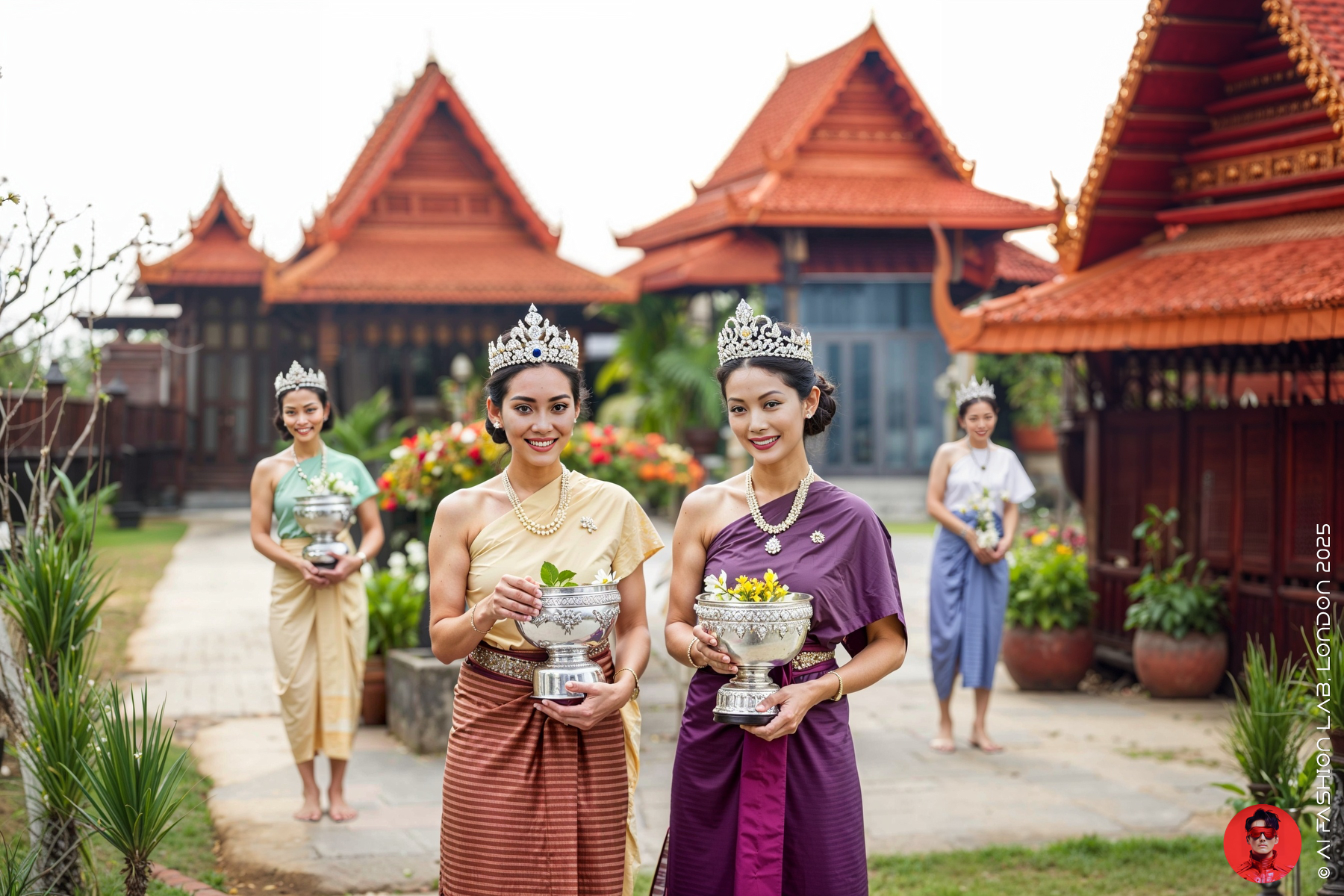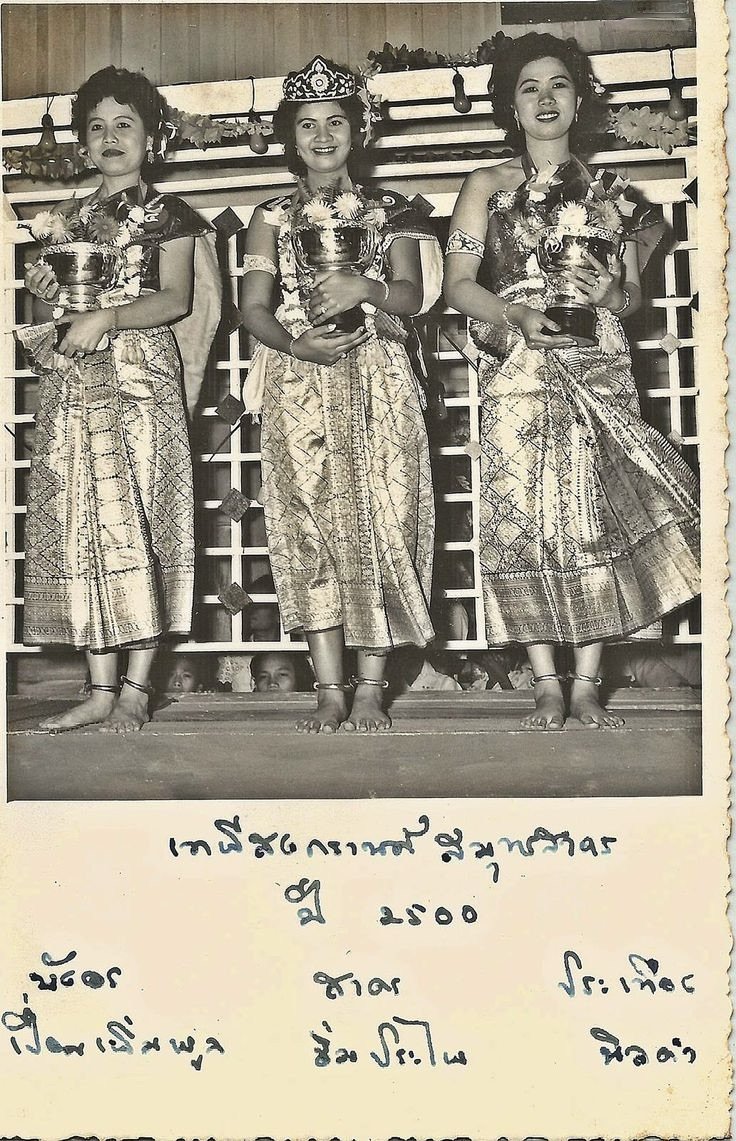จาก “นางสาวสยาม” สู่ “นางสงกรานต์พระประแดง” ทศวรรษ ๒๔๗๐
จาก “นางสาวสยาม” สู่ “นางสงกรานต์พระประแดง”
คอลเลกชันแฟชั่นที่สร้างขึ้นด้วยเทคโนโลยี AI ชุดนี้ เป็นการเฉลิมฉลองมรดกทางวัฒนธรรมอันทรงคุณค่าของ ประเพณีสงกรานต์พระประแดง เทศกาลสำคัญของชาวไทยเชื้อสายมอญ (รามัญ) ซึ่งสืบทอดมาอย่างยาวนานและมีเอกลักษณ์เฉพาะถิ่น โดยได้รับแรงบันดาลใจจากความละเมียดละไมและสง่างามของ การประกวดนางสาวสยาม ในยุค 2470s (1930s) ซึ่งถือเป็นยุคทองแห่งความงามแบบหญิงไทยร่วมสมัย
รูปแบบการคัดเลือกนางสงกรานต์ของชาวมอญพระประแดงในอดีต คาดว่าอาจเป็นต้นแบบสำคัญที่ต่อมาได้ถูกนำไปใช้ในการจัดประกวดนางสงกรานต์ในพื้นที่ต่าง ๆ ทั่วประเทศไทย โดยเปลี่ยนจากการ “คัดเลือกสาวงามประจำปี” ให้กลายเป็นเวทีประกวดที่คล้ายคลึงกับการประกวด “นางสาวสยาม” ซึ่งเน้นความงดงาม ความสงบเสงี่ยม และกิริยามารยาทอันอ่อนช้อยของหญิงไทย
เทศกาลสงกรานต์พระประแดง จัดขึ้นในวันอาทิตย์ถัดจากวันสงกรานต์ทั่วไป ซึ่งตรงกับช่วงปลายเดือนเมษายน อันเป็นเวลาสิ้นสุดฤดูเก็บเกี่ยว ชาวบ้านจึงถือโอกาสนี้รวมญาติ ทำบุญ บูชาบรรพบุรุษ และร่วมเฉลิมฉลองกันอย่างรื่นเริง ภายใต้บรรยากาศแห่งความผ่อนคลาย
หัวใจของประเพณีนี้คือ ขบวนแห่นางสงกรานต์ ซึ่งสะท้อนความงดงามตามขนบธรรมเนียมโบราณ โดยสาวงามจากแต่ละชุมชนจะได้รับเชิญเข้าร่วมขบวนผ่านวิธีการที่สืบทอดกันมายาวนาน คือ การมอบพานหมากพลูจีบ โดยผู้ใหญ่ที่ได้รับความเคารพนับถือจะเป็นผู้นำพานไปเชิญสาว ๆ ตามจำนวนที่ต้องการ ซึ่งผู้ใดได้รับพานหมากพลู ก็ถือเป็นการตอบรับเข้าร่วมขบวนแห่ในฐานะตัวแทนแห่งความงามของชุมชน
การแต่งกายของผู้เข้าร่วมขบวนในอดีตนั้นเรียบง่ายและเป็นไปตามความสะดวก โดยทั่วไปนิยมสวม โจงกระเบน ห่ม ผ้าสไบหรือ ผ้าถุง ตามที่หาได้ เมื่อสาว ๆ มารวมตัวกันครบ คณะกรรมการผู้ทรงคุณวุฒิจะพิจารณาคัดเลือกผู้ที่งามพร้อมที่สุดให้ดำรงตำแหน่ง นางสงกรานต์ประจำปี ส่วนผู้เข้าร่วมคนอื่น ๆ จะได้รับเกียรติเป็น นางฟ้า หรือ นางประจำปี ร่วมเดินขบวนด้วยกันอย่างสง่างาม
ต่อมาได้มีการปรับรูปแบบการคัดเลือกให้เป็นทางการมากยิ่งขึ้น โดยคณะผู้จัดจะพิจารณาสาวงามชาวพระประแดงแท้ล่วงหน้าก่อนถึงวันงาน เพื่อเชิญมาดำรงตำแหน่งนางสงกรานต์ประจำปีอย่างเหมาะสม
ผมได้นำภาพถ่ายต้นฉบับจากช่วงปี พ.ศ. 2480–2500 ซึ่งบันทึกเหตุการณ์การประกวดนางสงกรานต์และขบวนแห่ในอดีตมาใช้เป็นแรงบันดาลใจในการออกแบบแฟชั่นครั้งนี้ ภาพเหล่านี้ไม่เพียงเป็นหลักฐานทางประวัติศาสตร์ที่ทรงคุณค่า หากยังช่วยจุดประกายการสร้างสรรค์เครื่องแต่งกายย้อนยุคผ่านมุมมองร่วมสมัยด้วย AI
คอลเลกชันนี้จึงนำเสนอการแต่งกายที่ได้รับแรงบันดาลใจจากทั้ง การประกวดนางสาวสยาม และ การประกวดนางสงกรานต์พระประแดง โดยอิงจากแฟชั่นหญิงไทยในช่วง พ.ศ. 2470 เช่น สไบ โจงกระเบน ผ้านุ่ง และผ้าซิ่น เพื่อร้อยเรียงภาพแห่งความงามในจินตนาการของนางสงกรานต์แห่งพระประแดงในอดีต
From “Miss Siam” to “Miss Songkran of Phra Pradaeng”
This AI-generated fashion collection celebrates the rich cultural heritage of the Phra Pradaeng Songkran Festival, a unique and long-standing tradition of Thailand’s Mon (Raman) community. It draws inspiration from the grace and elegance of the Miss Siam pageants of the 1930s (B.E. 2470s), a golden era of modern Thai femininity.
The traditional method of selecting the Songkran beauty queen in the Mon community of Phra Pradaeng later became a model for Songkran beauty contests across Thailand. What began as an annual selection of local young women evolved into a formal pageant format, reflecting the influence of the Miss Siam contest—with its focus on poise, modesty, and traditional Thai values.
The Phra Pradaeng Songkran Festival is held on the Sunday following the national Songkran holiday, coinciding with the end of the harvest season in late April. It offers a special opportunity for families to reunite, make merit, honour ancestors, and celebrate together in a joyful and relaxed atmosphere.
At the heart of this tradition is the Miss Songkran parade, which beautifully preserves ancient customs. Each village selects its representative through a time-honoured ritual involving the presentation of a folded betel-leaf tray (phan maak pluu jeeb) by a respected elder. A young woman who accepts the offering is thus formally invited to represent her village in the parade.
Traditional attire for the parade was often simple and based on what could be found locally, with women typically wearing chong kraben, sabais, or tubular skirts (pha thung). Once the young women gathered, a panel of respected community members would select the most outstanding to be crowned Miss Songkran. The other participants would be honoured as yearly angels (nang pra jam pee) and join the procession with grace and pride.
In later years, the selection process became more formalised, with organisers identifying suitable candidates—true daughters of Phra Pradaeng—well in advance of the event to ensure their participation as the year’s official Miss Songkran.
To support the visual direction of this project, I incorporated historical photographs taken between 1950–1957 (B.E. 2493–2500), documenting real Miss Songkran contests and parades from the past. These images not only serve as valuable historical references but also inspire the imaginative recreation of period-specific fashion through contemporary AI technology.
This collection thus presents garments and accessories inspired by both the Miss Siam pageants and the Phra Pradaeng Miss Songkran tradition, drawing from Central Thai fashion of the 1930s—including sabais, chong kraben, pha nung, and traditional sin skirts—to reimagine the elegance of Miss Songkran in a nostalgic, idealised past.
#aifashionlab #AI #aiartist #aiart #aifashion #aifashiondesign #aifashionstyling #aifashiondesigner #fashion #fashionhistory #historyoffashion #fashionstyling #fashionphotography #digitalfashion #digitalfashiondesign #digitalcostumedesign #digitaldesign #digitalaiart #ThaiFashionHistory #ThaiFashionAI #flux #fluxlora


















































